Baseball in Medicine Hat
By Grace Christie
By Grace Christie
From the beginning the game of baseball had its supporters and players in the town.
Baseball was popular in the Territory from 1883-1905.
With the formation of a baseball association in 1888 interest really perked up. The Medicine Hat Baseball Club announced that it was prepared “to play any nine in the northwest for fun, money or marbles.” (Med Hat Times, July 6, 1888) Before the 1888 season was finished the Medicine Hat boys played teams from Calgary, Lethbridge and Donald, BC, winning most of their games.
The Baseball Association also upgraded the baseball diamond with much effort and money raised voluntarily. Some considered it the finest diamond in the entire Northwest. It was located on the North side of the river near the railway bridge.
The year 1888 saw the Medicine Hat baseball team do well playing throughout the Territory and entertaining many teams at home. On July 1, 1888 Lethbridge was in town to play the Medicine Hat team. According to the Medicine Hat Times of July 6, 1888, the home team got 6 runs in the first inning and then had many errors in the next inning allowing Lethbridge to score runs. The final score was 17-15 in favour of the home team! The Times also mentioned that “umpiring by Engineer James Fisher was perfect, if umpiring can be brought down to perfection and he was pronounced the best umpire in the land.”
The return match with Lethbridge was scheduled for August 6, 1888. Players and fans left Medicine Hat by train at 3 AM. The train arrived in Lethbridge at 11:15 AM and the game started at 2:30 PM. The final score was 13-10 for Medicine Hat. On returning home the team was treated to a banquet prepared by the ladies of the town.
At this time a number of baseball teams began competing locally. Apparently one game was between a team made up of single men and one made up of married men. The July 20, 1888 Medicine Hat Times reported that there was difficulty finding enough single men to compete and anyone who wanted to play was accepted to make the nine players needed. The married men also had some difficulty fielding a full team. After 5 innings of play the supper bells rang and the game ended as the married men were weary. The paper noted that because of the married men tiring, “the moral attached to this game will be that it will be a long time before a marriage again occurs in Medicine Hat. It’s a timely lesson to those who have not already committed matrimony.” It’s interesting to note that the married men won the game by a score of 14-1! In a return match on July 26 the singles won.
In March of 1889 the Medicine Hat Times reported on “The Baseball Squabble.” Apparently the Donald, BC club had been accused of buying umpires. A Mr.Upper had come to the Times office to report that “it was quite true that he was offered and accepted a sum of money from a private individual, friendly to the Donald team.” The Donald team won the game and the money was handed over to Mr. Upper. However since the Donald team won the game “straight” and Mr. Upper did not help in the least it was demanded that the money be given back. Mr. Upper stated that he told the backer “not muchly, you deposited this money for my benefit if Donald should prove victorious, and as they have, I have the money and propose keeping it.” Mr. Upper also claimed “that when the party was so anxious to put up his stuff to beat innocent parties, it was only right to teach him a lesson. In addition there was not an unjust decision throughout the game, nor would there have been one given, no matter what way the game was going.”
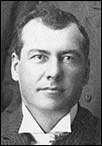 The Medicine Hat Times of May 18, 1889 reported that the baseball team had acquired new uniforms. These consisted of red and white caps, striped grey and white shirts, blue serge trousers and dark red hose. The captain of the team, who was elected for the year, was Mr. Alf Fidler. Mr. Fidler also organized and coached a junior baseball team that season. This team enjoyed a highly successful season. Fidler became known as the "father of baseball in Alberta."
The Medicine Hat Times of May 18, 1889 reported that the baseball team had acquired new uniforms. These consisted of red and white caps, striped grey and white shirts, blue serge trousers and dark red hose. The captain of the team, who was elected for the year, was Mr. Alf Fidler. Mr. Fidler also organized and coached a junior baseball team that season. This team enjoyed a highly successful season. Fidler became known as the "father of baseball in Alberta."
Also in 1889 The Lethbridge News covered a Dominion Day contest between teams from Medicine Hat and Lethbridge. Many fans from Medicine Hat traveled to Lethbridge for the “sole purpose of witnessing the contest.” The Lethbridge team won 17-9. One female Medicine Hat fan complained that “they were cheating by not throwing the ball so the visitors could hit it.”( Shoestring Glory, by Lewis St.George Stubbs)
On December 21, 1889 the Medicine Hat News reported that a baseball game had been played on December 19 between 2 picked nines. The weather was favourable with the exception of the strong Chinook winds. After five fairly good innings of play the score was 13-12 for the Crawfords over the Havertys.
1889 proved to be a very good year for the Medicine Hat baseball team as they won the final tournament of the year against Moose Jaw. This win marked a highly successful year for the team. The people of the town threw their support behind this baseball team as did the town leaders and businesses. Unfortunately there was a falling off of interest in the early 1890’s and the fortunes of the team waned.
In 1907 the Western Canada League (WCL) was formed with teams from Edmonton. Calgary, Lethbridge and Medicine Hat. In 1909 the league doubled in size with the addition of Moose Jaw, Regina, Brandon and Winnipeg. This was class D baseball, paying low wages and attracting “rough customers.” The players and managers were often assessed $5.00 fines for abusing the umpires.
The Medicine Hat News of May 23, 1907 reported that the opening game of this Western Canada League was played May 21 between Medicine Hat Mad Hatters and Calgary .The admission was $1.00 and over 400 fans attended. The News stated that the game was “one which kept the crowd roused to the highest pitch of excitement throughout, and several intricate and brilliant plays, which were pulled off by the locals, were accomplished in such a clean manner as to more than satisfy the locals with the material which will represent The Hat in the league this season.” The game had an unfortunate ending, as at the end of the seventh inning, the umpire benched two Hat players for arguing about his call of a strike which was out of reach. As there were no players to take the places of the men who were benched the Medicine Hat team had to be called off the field and the umpire awarded the game to Calgary by a score of 9-0. The score was 1-0 for The Hat before the umpire called the game! The News also reported that the umpire, Mr. Priest, “had played with the Calgary bunch around Boston for several seasons.”
The next day, May 22, 1907 Mayor Cousins made an address in front of the grandstand stating that “management would allow no betting, drinking or swearing on the grounds” so the public could attend games happily.(Medicine Hat News, May 23, 1907) Thus began Medicine Hat’s association with the Western Canada League!
During the spring of 1907 baseball made the front pages of the News regularly as The Hat team played well and won games in this new Western Canada League both at home and away. On June 20, 1907 the paper reported that the League proposed setting aside dates for games to be known as Ladies days. On these dates there would be no charge for ladies in recognition of “the hearty support which the ladies are giving the game.”
In his book Shoestring Glory, Lewis St.George Stubbs notes that in June 1907 an umpire was physically attacked in Lethbridge by two Lethbridge players for not calling the game because of darkness. “This outburst gave the game to Medicine Hat, one of the Hatter’s many triumphs on the road to the initial league championship.” Medicine Hat did win the first pennant of the WCL.
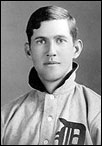 The manager of The Hat team, John Benny, who also played catcher, was given a lot of credit for the Team’s good showing in the first year of the WCL. The Edmonton Saturday News reported that “the fact that the pennant of the WCL baseball league for the season 1907 will float in the grounds of Medicine Hat demonstrates two things- first that Benny of the Hat is an A1 manager, and second that it pays to have a brainy man behind the bat.” Medicine Hat pitcher Ralph Works (right) led the league with 217 strikeouts. He later went on to play in the major leagues for Detroit Tigers and Cincinnati Reds.
The manager of The Hat team, John Benny, who also played catcher, was given a lot of credit for the Team’s good showing in the first year of the WCL. The Edmonton Saturday News reported that “the fact that the pennant of the WCL baseball league for the season 1907 will float in the grounds of Medicine Hat demonstrates two things- first that Benny of the Hat is an A1 manager, and second that it pays to have a brainy man behind the bat.” Medicine Hat pitcher Ralph Works (right) led the league with 217 strikeouts. He later went on to play in the major leagues for Detroit Tigers and Cincinnati Reds.
Unfortunately the Mad Hatters team ended this initial season with a deficit of $1,609 so the decision was made not to enter a team in the Western Canada League the next year.
However James Fleming, one of the most prominent persons in baseball circles in Medicine Hat, organized a city league in 1908. This league consisted of 4 amateur clubs; CPR, Fire Brigade, City and the Bachelors. It was called the Gas City Baseball League of Medicine Hat. Mr. W.G. Elliott donated a trophy.
Much to the delight of the local fans pro-baseball returned to The Hat in 1909. There were now 8 teams in the WCL: Winnipeg, Brandon, Regina, Moose Jaw, Medicine Hat, Lethbridge, Calgary and Edmonton. That year the WCL owners imposed profit sharing hoping to promote professional baseball across the prairies. There was a constitution which clearly set out the rules governing the league. This constitution prohibited betting and pool selling in the ball grounds. As well any player found guilty of striking an umpire would be expelled from the league.
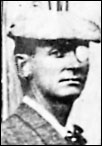 The manager, and first baseman, of the Medicine Hat team that year was an interesting character who went by the name of Billy Hamilton. Billy wore a patch over one eye to cover the loss of that eye in a baseball accident which ended his playing career in the States. His real name was Billy “Kid” Hulen. He had played professional ball in the American League as one of the few left-handed shortstops. After quitting ball he had disappeared in 1906 and was thought dead. There were no clues as to his whereabouts until it was reported that he was playing ball in Canada, namely Medicine Hat. His wife then divorced him for desertion. It was no wonder he declined to use his real name in Medicine Hat. His team did win the league championship again that year-1909.
The manager, and first baseman, of the Medicine Hat team that year was an interesting character who went by the name of Billy Hamilton. Billy wore a patch over one eye to cover the loss of that eye in a baseball accident which ended his playing career in the States. His real name was Billy “Kid” Hulen. He had played professional ball in the American League as one of the few left-handed shortstops. After quitting ball he had disappeared in 1906 and was thought dead. There were no clues as to his whereabouts until it was reported that he was playing ball in Canada, namely Medicine Hat. His wife then divorced him for desertion. It was no wonder he declined to use his real name in Medicine Hat. His team did win the league championship again that year-1909.
Unfortunately the team encountered financial difficulties once more and lost its professional baseball franchise in 1910. The Mad Hatters did go into action again before the outbreak of World War I.
 This first western league was marked by “players’ temper tantrums, drunken fans and gambling” but these were not the only ills associated with Prairie ball as “racism was by no means a purely American phenomenon.” For example in 1910, Medicine Hat refused to take the field against Regina whose third baseman, Dick Brookins, had “negroid features.” (See The Brookins Banishment - a stain on the reputation of the W.C.B.L.)
This first western league was marked by “players’ temper tantrums, drunken fans and gambling” but these were not the only ills associated with Prairie ball as “racism was by no means a purely American phenomenon.” For example in 1910, Medicine Hat refused to take the field against Regina whose third baseman, Dick Brookins, had “negroid features.” (See The Brookins Banishment - a stain on the reputation of the W.C.B.L.)
In 1913 there was a new low for rowdiness both on the field and in the stands. Umpires began to fear for their personal safety. In a Medicine Hat vs Saskatoon game the Saskatoon shortstop needed a police escort from the game after a debate with the umpire. Sometimes the fans also joined in the bullying after the games. The umpires then needed police protection to get to their cars.
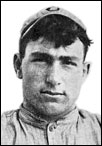
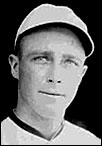 This “Class D baseball was either the starting point or the ultimate descent for a professional career.” (Shoestring Glory, Lewis St.George Stubbs). For instance, Ray Brown had played in the Majors before coming to Medicine Hat while Peter Joseph Schneider (left) and Elwood “Speed” Martin (right) both went on to play well for Major League teams.
This “Class D baseball was either the starting point or the ultimate descent for a professional career.” (Shoestring Glory, Lewis St.George Stubbs). For instance, Ray Brown had played in the Majors before coming to Medicine Hat while Peter Joseph Schneider (left) and Elwood “Speed” Martin (right) both went on to play well for Major League teams.
In 1914 the city hosted an All-American Girls team. This team played a team from Medicine Hat called the Independents. The Medicine Hat News of July 3, 1914 noted that “Girls who play baseball are not very common here in the west and girls who play it well enough to go up against the best amateur teams in the prairie provinces and beat most of them are certainly something very far out of the ordinary in athletic circles.” The paper noted that the team consisted of “all girls except the catcher. It having been difficult to find a lassie who could stand the frequent hard knocks incurred in working behind the log.” The paper also announced the rumour that all but four of the team “were men rigged out with wigs” was untrue.
In August 1914 the WCL disbanded when crowds diminished because of World War I. In 1919 the Western Canada League restarted but there were no Alberta teams in the league. In fact “during the period acknowledged as the golden era of minor-league baseball, the Prairies were without a pro team.” (Shoestring Glory, Lewis St. George Stubbs).Instead there was a Senior League in which the Medicine Hat team took part.
In 1919 Bill Findlay organized the Monarch Baseball club and professional baseball returned to the city. This team lasted for only 3 years but achieved an excellent record. The team achieved a record of 30 successive victories only meeting defeat at the hands of the Bassano Bearcats at the end of the season. Junior baseball was also popular in Medicine Hat at that time. One of the strongest junior teams was the Rotary club team of 1919 and 1920.
The Alberta Amateur Baseball Association was formed in 1921 and teams were organized in many of the surrounding communities. The Medicine Hat team played exhibition games against these teams attracting large crowds to the park.
Because there was no pro ball to speak of in western Canada barnstorming units began touring throughout the 1920’s and 1930’s. Dominion Day (July 1) weekend generally brought some good teams to play against local all star teams. Most of these barnstorming teams were “coloured” baseball teams from the US. These teams occasionally played each other and often played local all star teams. These games always drew a large attendance. Barnstorming, mostly by these “coloured” teams, continued into the 1940’s and 1950’s.
Baseball was still popular in The Hat in these years with junior and intermediate ball being sponsored by the Rotary club. Many of the elementary schools had both girls and boys teams who played for a city championship. There was also an industrial league which operated out of a diamond on Industrial and Allowance Avenue. The Medicine Hat Royals competed in a semi-pro league organized in 1934 by John Read. They competed against teams in Calgary and Lethbridge.
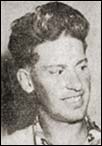 By 1950 Saskatchewan had a semi-pro circuit, the Southern League. In 1951 Medicine Hat joined this circuit and the Western Canada League was revised. However because of poor fan support the Medicine Hat team dropped out of the league the next year. Many of the players in this league were American college ball players. Red Nixon, a flamboyant promoter who owned the Swift Current club of the WCL, organized “cash” tournaments. One such tournament in Edmonton had $7200 in prize money. Many of the American college ballplayers could not resist the lure of these cash tournaments and went AWOL from their WCL teams in order to play in the cash tournaments. This version of the WCL lasted for 14 years.
By 1950 Saskatchewan had a semi-pro circuit, the Southern League. In 1951 Medicine Hat joined this circuit and the Western Canada League was revised. However because of poor fan support the Medicine Hat team dropped out of the league the next year. Many of the players in this league were American college ball players. Red Nixon, a flamboyant promoter who owned the Swift Current club of the WCL, organized “cash” tournaments. One such tournament in Edmonton had $7200 in prize money. Many of the American college ballplayers could not resist the lure of these cash tournaments and went AWOL from their WCL teams in order to play in the cash tournaments. This version of the WCL lasted for 14 years.
In 1956 The Rotary Club of Medicine Hat began sponsoring an annual baseball tournament. The first tournament was held in August and included professional and semi-professional teams from Montana, Saskatchewan and Alberta. The Rotary Club announced in its invitation to the teams that Medicine Hat had an excellent ball park with the “most modern flood lighting of any ball park in Western Canada.” That year 8 teams competed in a 7 game tournament over two days. The Medicine Hat team taking part was called the Medicine Hat Orphans. This tournament continued for several years.
In 1977 pro baseball appeared again in Medicine Hat when a Pioneer League franchise, operated by the Oakland A’s operated for that year. In 1978 the Medicine Hat entry in the Pioneer League became affiliated with the Toronto Blue Jays. This affiliation lasted for 25 years until 2003.
This Pioneer League actually had begun in 1939. This league was regarded as one of the better development leagues in minor league baseball. Many of the players went on to play in the big leagues.
For many years the Pioneer League teams came from Idaho, Montana and Utah. In 1975 Lethbridge entered the league and later the league expanded from 4 teams to 8 teams as Medicine Hat and Calgary also became part of the league. All teams were affiliated with major league clubs at that time.
At one time the League was considered a minor league and had a Class C label. Each year the League began in mid April and played 140 games. In 1964, because of the location of most of the teams, with cold northern nights in April and May and, because of restructuring, the Pioneer League became a league for first year professional players and became a short season ( 2 month schedule) league. When Medicine Hat joined the League in1977 the League games started in mid-June, and ended at the end of August. This allowed the 17-20 year old players to attend a full school year. However the teams played 70 games in 71 days!
In 1981 the Pioneer League was considered one of the strongest and most sound leagues in Minor League baseball. The League consisted of 8 teams at that time, all of whom were affiliated with a Major League club. The Medicine Hat Blue Jays, the Calgary Expos and the Lethbridge Dodgers were the Alberta clubs involved. The rest of the teams came from Montana and Idaho. It is interesting to note that in 1992 the Pioneer League in Alberta had 4 Alberta cities that started the Western Canada League in 1907.—Medicine Hat, Lethbridge, Edmonton and Calgary. The Medicine Hat Blue Jays won the league championship in 1982 and reached the playoffs in 1995 and 2000.

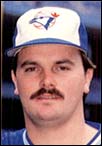 In 1992 when the home club, the Toronto Blue Jays, made it to the World Series there were six former medicine Hat Blue Jay players on the roster. These players were Jimmy Key (left), David Wells (right), Pat Borders, Mike Timlin, Randy Knorr and Mark Eichorn. Indeed over the years, up to then, seventeen players from the Medicine Hat team went on to the major leagues after playing in Medicine Hat. The General Manager of the Medicine Hat team, Kevin Friesen, noted that “Toronto’s philosophy has always been to draft the young kids, the high school kids, put them here. They’re going to make mistakes like they always do at this level. Then four, five years down the road, kids that were here are now in the major leagues.” Medicine Hat News, October 7, 1992.
In 1992 when the home club, the Toronto Blue Jays, made it to the World Series there were six former medicine Hat Blue Jay players on the roster. These players were Jimmy Key (left), David Wells (right), Pat Borders, Mike Timlin, Randy Knorr and Mark Eichorn. Indeed over the years, up to then, seventeen players from the Medicine Hat team went on to the major leagues after playing in Medicine Hat. The General Manager of the Medicine Hat team, Kevin Friesen, noted that “Toronto’s philosophy has always been to draft the young kids, the high school kids, put them here. They’re going to make mistakes like they always do at this level. Then four, five years down the road, kids that were here are now in the major leagues.” Medicine Hat News, October 7, 1992.
In June 1994, the two time World Champion Blue Jays came to Medicine Hat to play the National Baseball Institute Blues. This event caused the Medicine Hat News of May 14, 1994 to predict that this would be “one of the biggest sporting events in Medicine Hat’s history.” The Medicine Hat Blue Jay’s home field was prepared for the game by adding about 6000 bleacher seats, enclosing the park with a perimeter fence and putting up a new backstop. Much to the delight of nearly 10,000` fans, the National Baseball Institute Blues team of young amateurs, based in Surrey, B.C. defeated the World Champions 4-3.
After the 2002 season the Toronto Blue Jays ended their affiliation with the Medicine Hat club and the Pioneer League abandoned Medicine Hat. In 2003 the Medicine Hat Mavericks came into being to fill the void left when the Blue Jays left. The Mavericks are part of the Western Major Baseball League and in 2010 are still operating in The Hat. This league is Canada’s pre-eminent college baseball league. The players play in various college programs and in this league in the summer. The Mavericks begin play in June and play 48 games finishing the end of August.
With a long history, baseball continues to be a popular sport in Medicine Hat, both for participants and fans.
